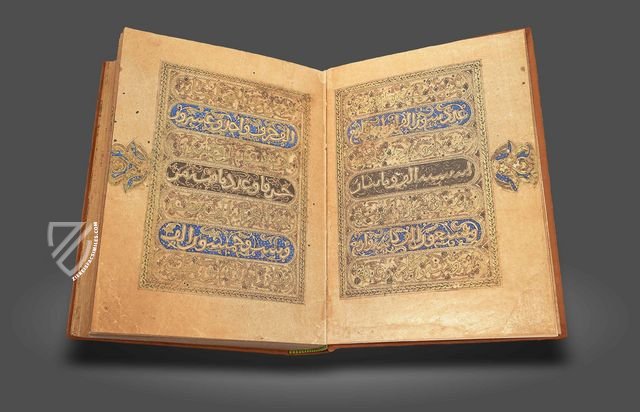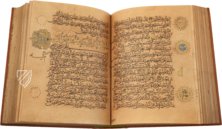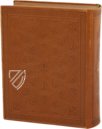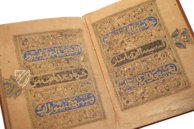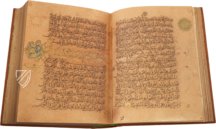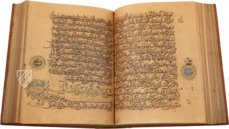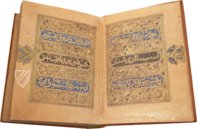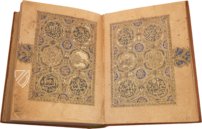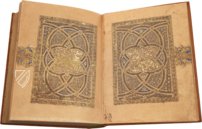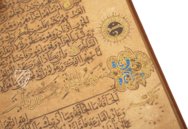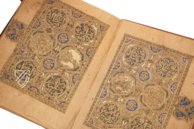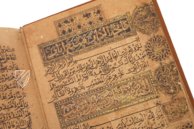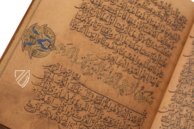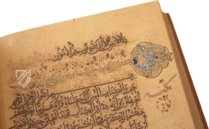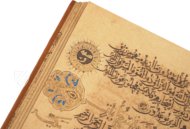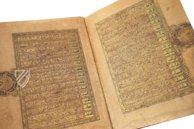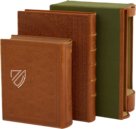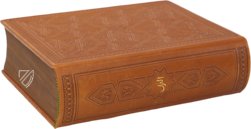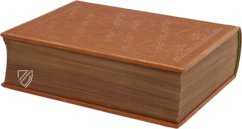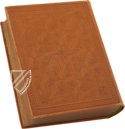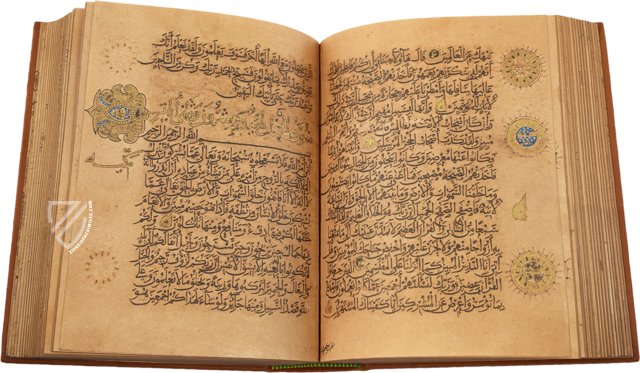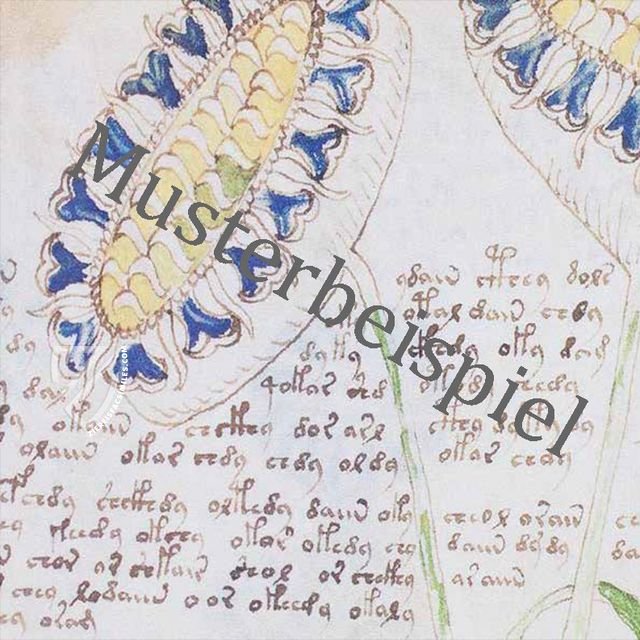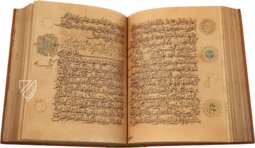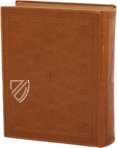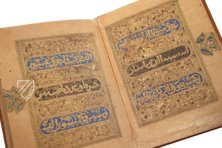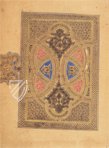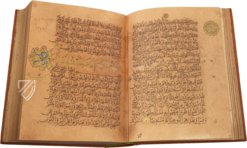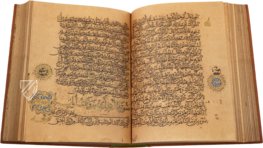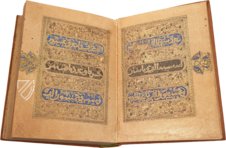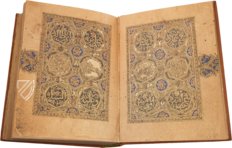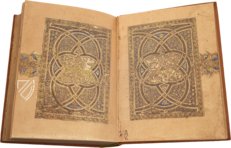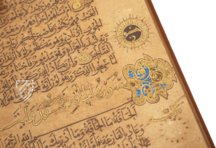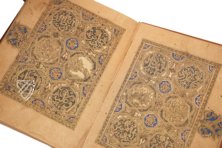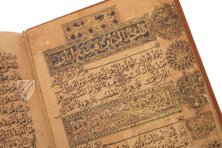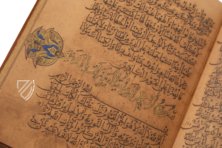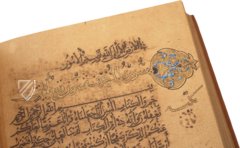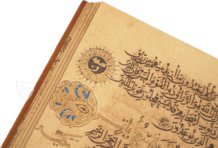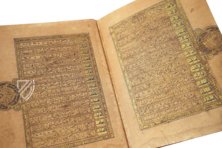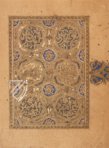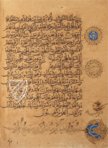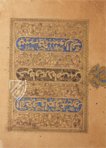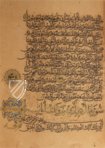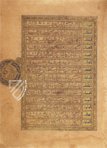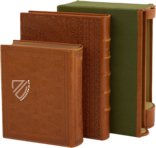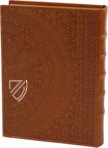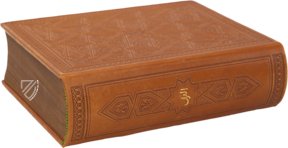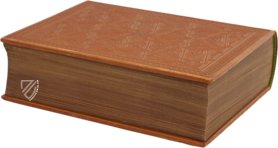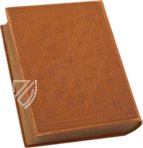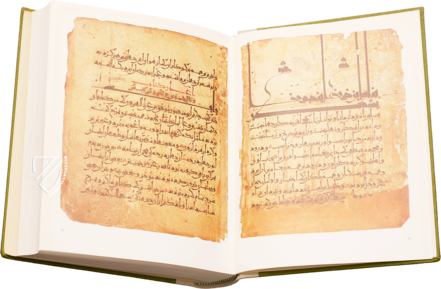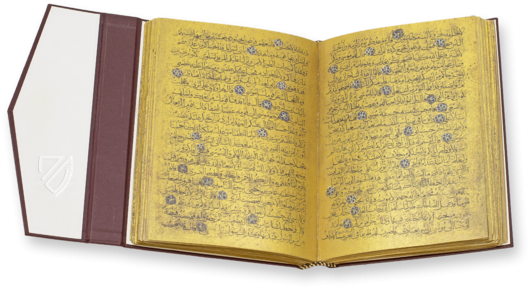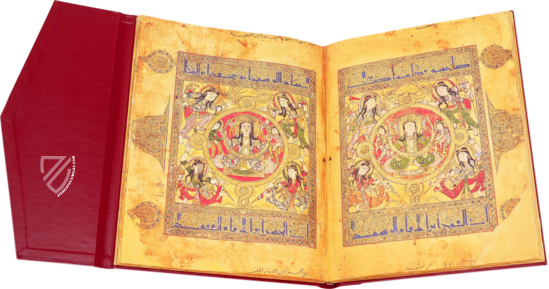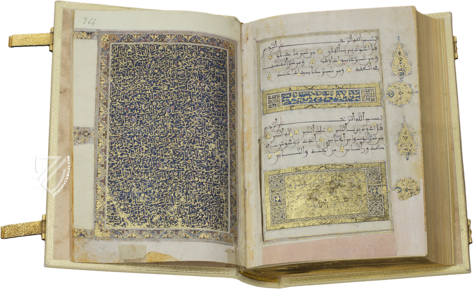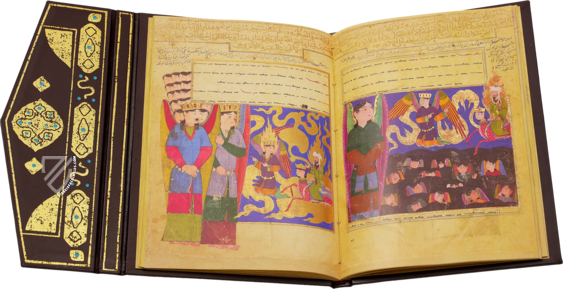Quran of Ibn al-Bawwab
(1,000€ - 3,000€)
This codex is one of the most famous Arabic Quran manuscripts due to the identity of the calligrapher. The manuscript was created at the beginning of the 11th century in Baghdad, where Ibn al-Bawwab is said to have produced about 60 Quranic manuscripts. Due to frequent changes of ownership, however, only this codex has been preserved and thus offers the only opportunity to gain insight into the work of this important calligrapher. How this Quran came to Ireland and into the possession of Chester Beatty, the founder of the library of the same name, is a mystery. For a long time, the value and significance of the manuscript remained unknown until Prof. David Storm Rice clearly identified it. Similarities with manuscripts preserved from the end of the 10th century and the beginning of the 11th century can probably be identified, but the stylistic idiosyncrasy of this Quran is immediately apparent.
Quran of Ibn al-Bawwab
This codex is one of the most famous Arabic Quran manuscripts due to the personality of the calligrapher: Ibn al-Bawwab (d. 1022) also known as Ali ibn-Hilal, Abu'l-Hasan, and Ibn al-Sitri was a famous calligrapher active in Baghdad during the Buyid period ** who reputedly produced 64 copies of the Quran. His highly coveted manuscripts passed through many hands and thus all but one are now lost. The **sole surviving Quran manuscript created by his skilled hand was created in the year 391H, which corresponds to AD 1000/01. Thus, it offers the only opportunity to gain insight into the work of such an important calligrapher and illuminator.
The Quran first came to Ireland as a gift of the Ottoman Sultan Selim I (1470–1512) and eventually came into the possession of Sir Alfred Chester Beatty (1875–1968), an American-British mining magnate the founder of his namesake library in Dublin. The value and significance of the manuscript remained unknown for a long time until Prof. David Storm Rice clearly identified it. Similarities with manuscripts preserved from the end of the 10th and the beginning of the 11th centuries can be identified, but the stylistic originality of this Quran is immediately apparent.
Innovations in Quranic Manuscript Production
The codex represents the oldest extant Quran written on paper as well as a transition in Quranic manuscript development. Aside from moving away from parchment, the new manuscripts were oriented vertically rather than horizontally. Ibn al-Bawwab also broke with tradition by abandoning Kufic script in favor of rounder, more legible scripts: the main text is written in Naskh (sometimes identified as Reyhan) while the opening pages, Sura headings, and statistical tables as the end of the manuscript were written using Thuluth script. These folios containing verse-counts were also expanded in this manuscript to contain information including the total word and letter count of each Sura, the word count of the entire manuscript, and the number of dotted and undotted letters.
Ibn al-Bawwab adopted new innovations in spacing: instead of spacing equally, he extended certain letters to then create asymmetrical gaps between words that draw the eyes of the reader across the page and also clearly marking new sections for easier identification. Individual verses on the other hand had no spaces between them and are demarcated by triangular clusters of blue dots with every fifth and tenth verse separated by a space with a standard gold marking.
The Mysterious Master Calligrapher
Little is known about the early life of this master illuminator and calligrapher. Ibn al-Bawwab literally translates as the “son of the doorkeeper” and is an indication of his humble origins, which was unusual for an artist during that period. He began his career as a home decorator before becoming an illuminator and eventually a calligrapher. Closely attached to the vizier Fakhr al Mulk Abu Ghalib Muhammad b. Khalaf at Baghdad, he rose to be among the ranks of the government administration and was in charge of the library of Buwayhid Baha´ al-Dawla at Shiraz for a period. He was also a devout man who knew the Quran by heart and is said to have produced 64 copies of it, and a man of letters who was well versed in the law as well as authoring a treatise and a didactic poem on the art of writing. His real title to fame, however, according to the early Arab authors, was to have perfected the style of writing invented, about a century earlier, by his famous predecessor, the vizier Ibn Mukla and to have brought it to a degree of well-balanced elegance which was to be surpassed later only by the efforts of Yakut al-Musta'simi.
Codicology
- Alternative Titles
- Koran of Ibn al-Bawwab
Der Koran des Ibn al-Bawwab
Le Coran - Size / Format
- 564 pages / 13.7 × 11.7 cm
- Origin
- Iraq
- Date
- 1000–01
- Epochs
- Style
- Language
- Script
- Naskh Rayhani script
- Illustrations
- Five ornamentally and calligraphically illuminated double-pages as well as golden sura-headings and embellished verse markers throughout
- Artist / School
- Ibn al-Bawwab (scribe and illuminator)
Quran of Ibn al-Bawwab
Folio 120 recto
This detail shows one of the many beautiful sura headings in the sublime ornamental script Thuluth, whose large golden letters contrast with the paper by their fine black outline. The script is connected to a magnificent palmette ornament in the margin, which further emphasises the beginning of the new sura. This functional and at the same time splendid ornament is also outlined in black and consists of golden leaves and tendrils on a brilliant blue background. In contrast to this richly illuminated heading, the Āyāt (verses) in dark brown Naskh script appear downright plain despite their calligraphic sophistication, which, however, benefits their readability.
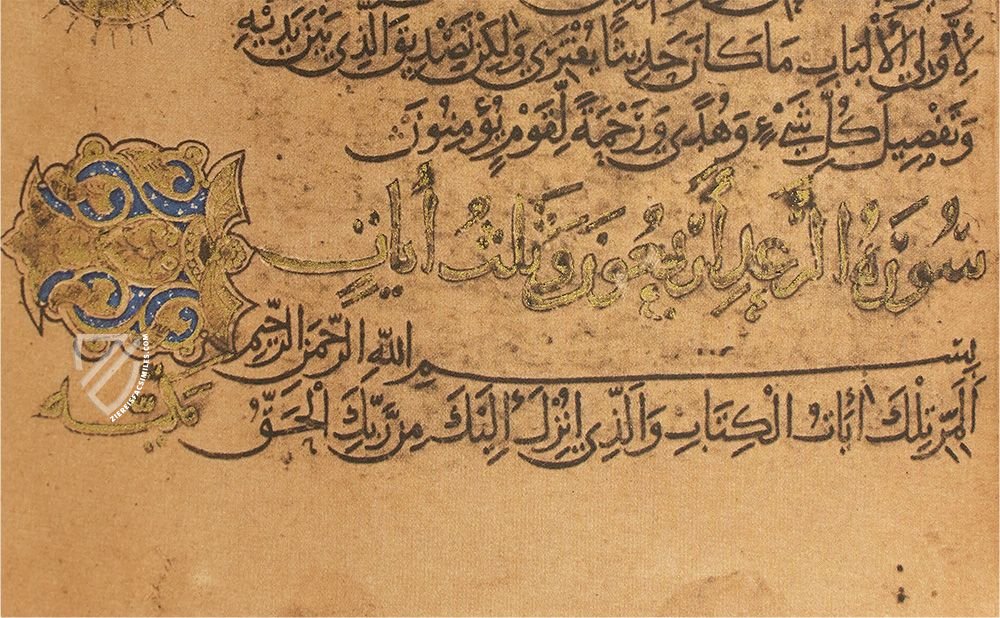
Quran of Ibn al-Bawwab
Carpet Page
The decorative opening pages of the manuscript include this magnificent geometrically designed miniature of a prayer rug with an intricate border. Its design consists of six octagonal medallions, each containing script with a Quranic verse and flowering tendrils. Further floral patterns appear between these octagons, including small blue octagons with flowers.
The color palette of this miniature page is limited to gold, blue, brown, and black, although much of the gold leaf has peeled off after centuries of use. This is a fine example of the advanced combinations of floral and geometric patterns created by Muslim artists who were forbidden from depicting the human form in religious art, be it a manuscript miniature or a mosaic in a mosque.
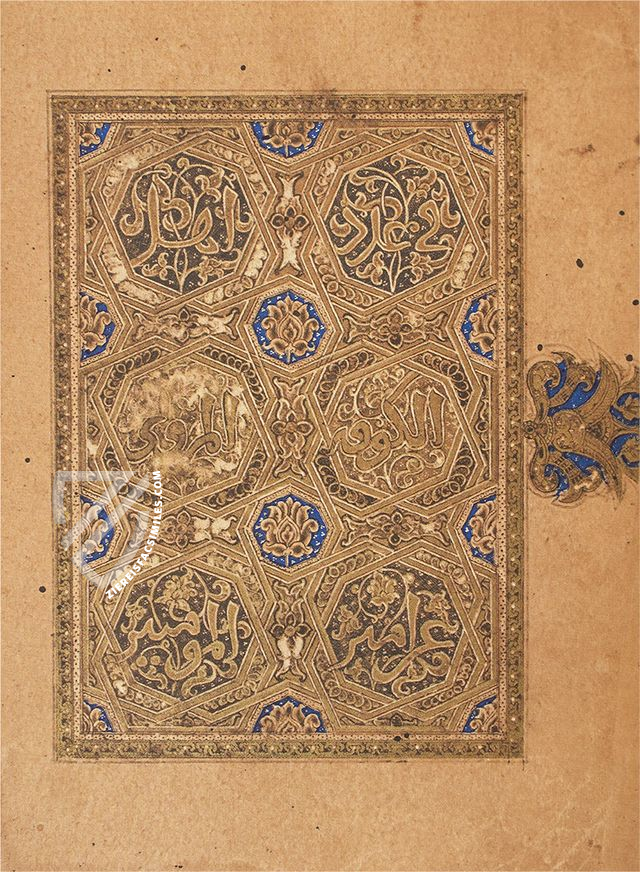
#1 Der Koran des Ibn al-Bawwab
Languages: Arabic, English
(1,000€ - 3,000€)
#2 Manuscript D'Ibn al-Bawwab
Languages: French, English
- Treatises / Secular Books
- Apocalypses / Beatus
- Astronomy / Astrology
- Bestiaries
- Bibles / Gospels
- Chronicles / History / Law
- Geography / Maps
- Saints' Lives
- Islam / Oriental
- Judaism / Hebrew
- Single Leaf Collections
- Leonardo da Vinci
- Literature / Poetry
- Liturgical Manuscripts
- Medicine / Botany / Alchemy
- Music
- Mythology / Prophecies
- Psalters
- Other Religious Books
- Games / Hunting
- Private Devotion Books
- Other Genres
- Afghanistan
- Armenia
- Austria
- Belgium
- Belize
- Bosnia and Herzegovina
- China
- Colombia
- Costa Rica
- Croatia
- Cyprus
- Czech Republic
- Denmark
- Egypt
- El Salvador
- Ethiopia
- France
- Germany
- Greece
- Guatemala
- Honduras
- Hungary
- India
- Iran
- Iraq
- Israel
- Italy
- Japan
- Jordan
- Kazakhstan
- Kyrgyzstan
- Lebanon
- Liechtenstein
- Luxembourg
- Mexico
- Morocco
- Netherlands
- Palestine
- Panama
- Peru
- Poland
- Portugal
- Romania
- Russia
- Serbia
- Spain
- Sri Lanka
- Sweden
- Switzerland
- Syria
- Tajikistan
- Turkey
- Turkmenistan
- Ukraine
- United Kingdom
- United States
- Uzbekistan
- Vatican City
- A. Oosthoek, van Holkema & Warendorf
- Aboca Museum
- Ajuntament de Valencia
- Akademie Verlag
- Akademische Druck- u. Verlagsanstalt (ADEVA)
- Aldo Ausilio Editore - Bottega d’Erasmo
- Alecto Historical Editions
- Alkuin Verlag
- Almqvist & Wiksell
- Amilcare Pizzi
- Andreas & Andreas Verlagsbuchhandlung
- Archa 90
- Archiv Verlag
- Archivi Edizioni
- Arnold Verlag
- ARS
- Ars Magna
- ArtCodex
- AyN Ediciones
- Azimuth Editions
- Badenia Verlag
- Bärenreiter-Verlag
- Belser Verlag
- Belser Verlag / WK Wertkontor
- Benziger Verlag
- Bernardinum Wydawnictwo
- BiblioGemma
- Biblioteca Apostolica Vaticana (Vaticanstadt, Vaticanstadt)
- Bibliotheca Palatina Faksimile Verlag
- Bibliotheca Rara
- Boydell & Brewer
- Bramante Edizioni
- Bredius Genootschap
- Brepols Publishers
- British Library
- C. Weckesser
- Caixa Catalunya
- Canesi
- CAPSA, Ars Scriptoria
- Caratzas Brothers, Publishers
- Carus Verlag
- Casamassima Libri
- Centrum Cartographie Verlag GmbH
- Chavane Verlag
- Christian Brandstätter Verlag
- Circulo Cientifico
- Club Bibliófilo Versol
- Club du Livre
- CM Editores
- Collegium Graphicum
- Collezione Apocrifa Da Vinci
- Comissão Nacional para as Comemorações dos Descobrimentos Portugueses
- Coron Verlag
- Corvina
- CTHS
- D. S. Brewer
- Damon
- De Agostini/UTET
- De Nederlandsche Boekhandel
- De Schutter
- Deuschle & Stemmle
- Deutscher Verlag für Kunstwissenschaft
- DIAMM
- Droz
- E. Schreiber Graphische Kunstanstalten
- Ediciones Boreal
- Ediciones Grial
- Ediclube
- Edições Inapa
- Edilan
- Editalia
- Edition Deuschle
- Edition Georg Popp
- Edition Leipzig
- Edition Libri Illustri
- Editiones Reales Sitios S. L.
- Éditions de l'Oiseau Lyre
- Editions Medicina Rara
- Editorial Casariego
- Editorial Mintzoa
- Editrice Antenore
- Editrice Velar
- Edizioni Edison
- Egeria, S.L.
- Eikon Editores
- Electa
- Emery Walker Limited
- Enciclopèdia Catalana
- Eos-Verlag
- Ephesus Publishing
- Ernst Battenberg
- Eugrammia Press
- Extraordinary Editions
- Fackelverlag
- Facsimila Art & Edition
- Facsimile Editions Ltd.
- Facsimilia Art & Edition Ebert KG
- Faksimile Verlag
- Feuermann Verlag
- Folger Shakespeare Library
- Franco Cosimo Panini Editore
- Friedrich Wittig Verlag
- Fundación Hullera Vasco-Leonesa
- G. Braziller
- Gabriele Mazzotta Editore
- Gebr. Mann Verlag
- Gesellschaft für graphische Industrie
- Getty Research Institute
- Giovanni Domenico de Rossi
- Giunti Editore
- Graffiti
- Grafica European Center of Fine Arts
- Guido Pressler
- Guillermo Blazquez
- Gustav Kiepenheuer
- H. N. Abrams
- Harrassowitz
- Harvard University Press
- Helikon
- Hendrickson Publishers
- Henning Oppermann
- Herder Verlag
- Hes & De Graaf Publishers
- Hoepli
- Holbein-Verlag
- Houghton Library
- Hugo Schmidt Verlag
- Idion Verlag
- Il Bulino, edizioni d'arte
- ILte
- Imago
- Insel Verlag
- Insel-Verlag Anton Kippenberger
- Instituto de Estudios Altoaragoneses
- Instituto Nacional de Antropología e Historia
- Istituto dell'Enciclopedia Italiana - Treccani
- Istituto Ellenico di Studi Bizantini e Postbizantini
- Istituto Geografico De Agostini
- Istituto Poligrafico e Zecca dello Stato
- Italarte Art Establishments
- Jan Thorbecke Verlag
- Johnson Reprint Corporation
- Josef Stocker
- Josef Stocker-Schmid
- Jugoslavija
- Karl W. Hiersemann
- Kasper Straube
- Kaydeda Ediciones
- Kindler Verlag / Coron Verlag
- Kodansha International Ltd.
- Konrad Kölbl Verlag
- Kurt Wolff Verlag
- La Liberia dello Stato
- La Linea Editrice
- La Meta Editore
- Lambert Schneider
- Landeskreditbank Baden-Württemberg
- Leo S. Olschki
- Les Incunables
- Liber Artis
- Library of Congress
- Libreria Musicale Italiana
- Lichtdruck
- Lito Immagine Editore
- Lumen Artis
- Lund Humphries
- M. Moleiro Editor
- Maison des Sciences de l'homme et de la société de Poitiers
- Manuscriptum
- Martinus Nijhoff
- Maruzen-Yushodo Co. Ltd.
- MASA
- Massada Publishers
- McGraw-Hill
- Metropolitan Museum of Art
- Militos
- Millennium Liber
- Müller & Schindler
- Nahar - Stavit
- Nahar and Steimatzky
- National Library of Wales
- Neri Pozza
- Nova Charta
- Oceanum Verlag
- Odeon
- Orbis Mediaevalis
- Orbis Pictus
- Österreichische Staatsdruckerei
- Oxford University Press
- Pageant Books
- Parzellers Buchverlag
- Patrimonio Ediciones
- Pattloch Verlag
- PIAF
- Pieper Verlag
- Plon-Nourrit et cie
- Poligrafiche Bolis
- Presses Universitaires de Strasbourg
- Prestel Verlag
- Princeton University Press
- Prisma Verlag
- Priuli & Verlucca, editori
- Pro Sport Verlag
- Propyläen Verlag
- Pytheas Books
- Quaternio Verlag Luzern
- Reales Sitios
- Recht-Verlag
- Reichert Verlag
- Reichsdruckerei
- Reprint Verlag
- Riehn & Reusch
- Roberto Vattori Editore
- Rosenkilde and Bagger
- Roxburghe Club
- Salerno Editrice
- Saltellus Press
- Sandoz
- Sarajevo Svjetlost
- Schöck ArtPrint Kft.
- Schulsinger Brothers
- Scolar Press
- Scrinium
- Scripta Maneant
- Scriptorium
- Shazar
- Siloé, arte y bibliofilia
- SISMEL - Edizioni del Galluzzo
- Sociedad Mexicana de Antropología
- Société des Bibliophiles & Iconophiles de Belgique
- Soncin Publishing
- Sorli Ediciones
- Stainer and Bell
- Studer
- Styria Verlag
- Sumptibus Pragopress
- Szegedi Tudomànyegyetem
- Taberna Libraria
- Tarshish Books
- Taschen
- Tempus Libri
- Testimonio Compañía Editorial
- Thames and Hudson
- The Clear Vue Publishing Partnership Limited
- The Facsimile Codex
- The Folio Society
- The Marquess of Normanby
- The Richard III and Yorkist History Trust
- Tip.Le.Co
- TouchArt
- TREC Publishing House
- TRI Publishing Co.
- Trident Editore
- Tuliba Collection
- Typis Regiae Officinae Polygraphicae
- Union Verlag Berlin
- Universidad de Granada
- University of California Press
- University of Chicago Press
- Urs Graf
- Vallecchi
- Van Wijnen
- VCH, Acta Humaniora
- VDI Verlag
- VEB Deutscher Verlag für Musik
- Verlag Anton Pustet / Andreas Verlag
- Verlag Bibliophile Drucke Josef Stocker
- Verlag der Münchner Drucke
- Verlag für Regionalgeschichte
- Verlag Styria
- Vicent Garcia Editores
- W. Turnowski Ltd.
- W. Turnowsky
- Waanders Printers
- Wiener Mechitharisten-Congregation (Wien, Österreich)
- Wissenschaftliche Buchgesellschaft
- Wissenschaftliche Verlagsgesellschaft
- Wydawnictwo Dolnoslaskie
- Xuntanza Editorial
- Zakład Narodowy
- Zollikofer AG

